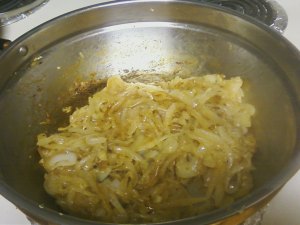 For those of you who haven’t been paying attention to the recent weather reports, a cold snap has hit the Northwest, complete with snow, ice, and the usual crazy Seattlites who can’t drive in snow (or a light rain, for that matter.) We have a blanket of fluffy, crystalline snow all over, and it’s making the trees look like Christmas decorations, two weeks too late.
For those of you who haven’t been paying attention to the recent weather reports, a cold snap has hit the Northwest, complete with snow, ice, and the usual crazy Seattlites who can’t drive in snow (or a light rain, for that matter.) We have a blanket of fluffy, crystalline snow all over, and it’s making the trees look like Christmas decorations, two weeks too late.
On the plus side, winter snow brings winter hungers, and I love nothing more than warm, hearty soups. And, since I’ve been dying to try this tomato bisque recipe for a while, I figured this would be a perfect time to try it. And to make things even better, this version of the soup serves two hungry people (or four appetizers) for less than 150 calories per (or 75, if you use it as an appetizer.) It’s light, airy, and full of flavor.
Now, I know you’ll have a few questions about the ingredients, and believe me, they’re all necessary, but, in explanation:
- The soy and anchovies are for depth of flavor. They’re odd ingredients, I know, but they do worlds of good for the deep, rich flavor of this soup.
- You can add more cream, or sour cream (M suggested neufchâtel , which I’m quite excited to try) to ramp up the creamy flavor, but this soup does well enough as is.
- The roasted garlic definitely a win. I felt that it added a very subtle undertone to the soup that worked well.
Pheasant’s tomato bisque
4 beefsteak or heirloom tomatoes
3 roma tomatoes
3 cloves raw garlic
1/2 c finely chopped onion
2 tbsp roasted garlic mash (optional but recommended)
1 anchovy filet
1 tbsp soy sauce (Aloha brand highly suggested)
1 tsp vegetable oil (I used some of the roasted garlic oil)
1/2 c chicken or vegetable broth (optional)
1-3 basil leaves, to preference
1 tbsp ground dried rosemary (measure after grinding)
1 bay leaf
1/8 tsp cayenne
1 tbsp fat free sour cream (for garnish)
Using a paring knife, cut a small X into the bottom of each tomato, and cut the core out of the top.  Fill a small (3-5 qt) sauce pot with water and bring it to a boil. While it’s heating, set up an empty bowl on the stove, as well as a bowl filled with cold water and ice cubes. Once the water is boiling, drop the tomatoes in one at a time. Count to fifteen slowly, then take them out with a slotted spoon and place them in the ice bath. You should see the skin beginning to peel off and split from the tomato at this point. After a moment, transfer the tomatoes into the empty bowl.
Fill a small (3-5 qt) sauce pot with water and bring it to a boil. While it’s heating, set up an empty bowl on the stove, as well as a bowl filled with cold water and ice cubes. Once the water is boiling, drop the tomatoes in one at a time. Count to fifteen slowly, then take them out with a slotted spoon and place them in the ice bath. You should see the skin beginning to peel off and split from the tomato at this point. After a moment, transfer the tomatoes into the empty bowl.
After each tomato has been boiled and bathed, rub the skin splits and peel the tomatoes. Set them aside. 
Empty the sauce pot of water and place it back on the burner, at medium heat. Add the oil and onion, as well as the rosemary and cayenne. Allow them to sweat and begin to brown. While they cook, mince the raw garlic very finely. Add it, stir, and add in the anchovy filet. Mash the filet to break it up a bit. Turn the burner down to low.
Slice and seed the peeled tomatoes. Seeding is critical here…if you don’t, you’ll have way too much liquid, and those seeds don’t taste very good. Dice them, and add about two tomatoes’ worth to the pot. Turn it up to medium and let that cook down while you dice the remaining tomatoes.
Allow the two diced tomatoes in the pan cook down until a medium fond develops. Deglaze with half the chicken broth and the soy sauce. Then, add the remaining tomatoes, the roasted garlic, basil leaves and the bay leaf. Allow it to simmer for about twenty minutes.
Using a hand blender, blend the soup to a smooth, silken consistency. If you don’t own a hand blender (like we don’t) allow it to cool, then blend in the blender or Magic Bullet.
After you’ve blended it, taste and correct for spices depending on your preferences, then dish it up, top it with sour cream (or cream, or softened cream cheese) and watch it disappear! 
Because of the soft, creamy and sweet tastes that go along with this soup, M and I served it up alongside some best-ever roasted potatoes (recipe to follow) and happily sat down to eat. I must warn you, this soup is soup-er filling (how could I write this entire post without using that pun?!) and one bowl was too much for either of us to handle in one sitting. Considering how I can pack away food…that’s really saying something. Enjoy!













